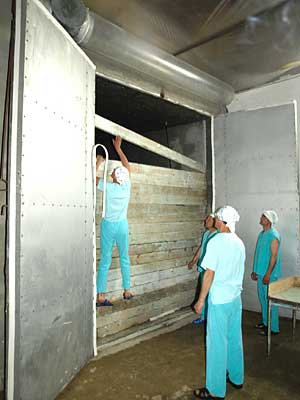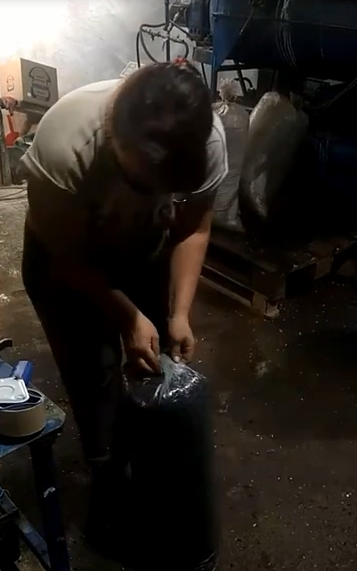Most videos on YouTube say that you take sawdust, soak it in a lime solution, then mix it with grain spawn and put the mixture into bags. That's all - the mushroom block is ready!
This method is good if growing mushrooms is your hobby. And after a while you will not be able to use this method, because mold spores accumulate in the place where you make the substrate and it will be defective.
If you have a farm where mushrooms are grown for sale, you need to allocate a special room for making mushroom blocks.
6. Disinfection of the clean area
The clean zone is a room in which mushroom blocks are made. It is also called the inoculation room, clean area or seeding room.
It is called a clean zone because it requires thorough disinfection before and after each seeding (inoculation).

Workers should not leave the inoculation room during inoculation to avoid introducing spores from the outside on their clothing and with air currents when opening the door.
If you pasteurize the substrate in a tunnel, then one door (gate) of the tunnel should be used to load raw materials for steaming.
And the second doors (gates) should open into a seeding room; they open after the substrate cooling process is completed.
The second tunnel door must be closed. You take the substrate in a seeding room and make blocks.
If you are making the substrate in any other way, such as sterilizing the raw material in an autoclave, pouring hot water or a lime solution into it, you will need to have an opening or window into the clean area that will allow the substrate to be delivered so that mold and bacteria spores do not enter the inoculation room.
Seeding (seeding) or inoculation of mycelium is the introduction of grain with oyster mushroom mycelium into a substrate cooled to 23-25 degrees.
Grain mycelium is most often thoroughly mixed with the substrate on the inoculation table.
In this case, the grain is distributed evenly, the hyphae germinate faster and more evenly in all zones and suppress the development of competitors.
However, when using certain types of raw materials (for example, various cotton waste), the mycelium is added in thin layers, placed between the film and the substrate. Mushroom growers say that mycelium grows better with this method. Therefore, you need to check which method is more suitable in your case.
After sterilizing the substrate in an autoclave, the mycelium is introduced through a special device into the center of the bag.
Blocks for sterilization in an autoclave are made in small sizes, their weight is usually no more than 2.5-3 kg, so the mycelium grows well throughout the entire volume of the package.
The size of the room depends on the amount of substrate, and therefore the people inoculating it.
If you use mechanisms that pack blocks, the dimensions of the room are determined taking into account the size and height of these mechanisms.
Also in the room you need to provide a table for scales on which the mycelium is weighed, bowls for kneading the mycelium, floor scales for weighing the substrate and a place where the finished mushroom blocks will lie until they are taken from the clean area.
Also in the inoculation room there should be doors that lead to the locker room. In it, workers change into clean clothes before seeding. There should be a toilet and washbasin.
At least primitive ventilation should be provided in the seeding room. If your room is small, you can put a filter on the window and place an axial kitchen fan on the opposite wall.
If the room area is more than 16-20 sq.m., you need to use a blower fan, which will create a slight excess pressure so that spores do not penetrate from the outside through the cracks. The air that the fan forces into the inoculation room must also go through a filter.

If you have a pasteurization tunnel for 10-15 tons of substrate, it is advisable to purchase a press with hydraulic cylinders for making blocks, since it is impossible to sow manually in one day.
For large tunnels with a loading of 20-30 tons of substrate, mechanized lines for packaging mushroom blocks are sold, with conveyors along which the substrate moves and a mycelium dispenser.
If you sow 3-5 tons of substrate each time, it is very convenient to make a large table, 4-5 meters long and 1.4-1.5 meters wide.
A certain amount of suspended substrate is poured onto it, then it is evenly sprinkled with mycelium, which must also be weighed. Then this mass is mixed and packaged.
For ease of packaging, you can make holes at one end of the table that have a conical attachment at the bottom.
A bag is inserted into the nozzle and the mixture from the table is transferred into the bag.
What do you need to know?
The grain spawn is heated to room temperature.
You need to put it out of the refrigerator in a warm place 12-15 hours before seeding. During this time, it not only heats up, but its activity and the functioning of enzyme systems are restored.
Therefore, once in the treated husk or straw, the mycelium immediately begins to grow. If you use it cold, moisture from the warm substrate condenses on the grain, creating a local soaked area.
This can trigger the development of green mold directly on the grain. This does not mean that the mycelium has been damaged.
Most often, this means that too many mold spores have survived your processing method. And using cold spawn simply allowed the spores to develop on the wet grain.
Each packet of mycelium is kneaded separately in a bowl. You should not mix the contents of several packages, because in one of them the spawn may be damaged, or by chance it will be a different strain.
Don't worry if the white color disappears as a result of kneading the grain. The mycelium is found not only on the surface, but also inside each grain.
Crushed spawn must be weighed.
Spawn to substrate ratio
I have a video about the proportion of adding spawn to the substrate, watch it.
What size bag for oyster mushrooms? What bags to use for mushrooms?
If you use a press with hydraulic cylinders (it's here in the photo above.), you do not need bags, but a sleeve of polyethylene film 35-38 cm wide. Then the block will have a diameter of 22-23 cm.
The sleeve needs to be cut into pieces 20-30 cm larger than the height of the block.
 These 20-30 cm of excess film are needed to tie the ends of the block or seal them with tape.
These 20-30 cm of excess film are needed to tie the ends of the block or seal them with tape.
We asked the company where we bought the sleeve to cut the sleeve into 90 cm long pieces, and we took 5,000 cut pieces from them at a time. This amount was enough for us for 1 month - I had a pasteurization tunnel for 10 tons of substrate, and we made 5-6 seedings per month.
The packaged substrate is tied with twine or sealed with tape. When tying, thoroughly squeeze out the air from under the film with one hand, while at the same time twisting and collecting the polyethylene with the other hand, and then tie.
When using tape, after folding the film into an “envelope,” you need to squeeze out the air from under it, and only then seal it.
In this case, it is convenient to use a tape dispenser.
Once you have tied the blocks, they can be transferred to the incubator if there is a door leading into it directly from the clean area.
Many farms have a window in the inoculation room through which workers pass accumulated blocks from time to time.
If you are making 50-100 blocks in total, just provide a place for them in the inoculation room. You can transfer them to the incubator after seeding is complete.
Different countries have their own requirements for disinfection of various premises. In some countries, many chemicals are banned. For example, insecticides. You need to find drugs that kill, or at least inhibit, mold and bacteria spores. Please note - the drugs must act specifically on the spore forms!
Preparations based on quaternary ammonium bases are now popular, and many of them have a sporicidal effect. They can be used to disinfect a clean area according to the instructions for the product.
Read about how to treat a clean area with waterline peroxide and sodium hypochlorite here.
